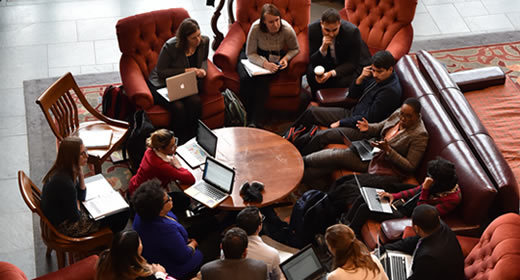
Last year, the Ford School developed new undergraduate and graduate student recruitment procedures--objectives that were outlined in the school's five-year plan for diversity, equity, and inclusion (DE&I).
The goal of the expanded recruitment efforts: To diversify both the applicant pool, and by extension the student body, in legally permissible ways.
"Policy professionals must engage with diverse perspectives and populations, so gaining experience in doing so here at the Ford School is crucial to our educational mission," says Susan Guindi, director of student and academic services.
The strategic recruiting plans were approved by the school's Executive Committee and implemented by the admissions team during the fall 2016 recruitment season. While it's too early to assess the long-term impact of the new recruiting procedures, a first peek at early results, particularly at the undergraduate level, seems very promising.
Thirty one percent of the students in the applicant pool for this year's BA class as well as in the matriculated pool were domestic students of color. When compared to our 10-year average of 19 percent, that's a 12 percent--and very significant--increase in undergraduate diversity.
Enhanced undergraduate recruitment efforts included expanded use of social media, working with undergraduate student leaders to provide information to prospective applicants, having student ambassadors establish new recruitment events with student organizations across campus, and communicating with faculty and staff of U-M's Comprehensive Studies Program and Department of Economics to disseminate program information to promising students.
While the admissions deadline is still pending for the master's program, 31.4 percent of this year's domestic applicants are students of color. Although this is not a statistically significant increase from 2016, when the Ford School's graduate program was recognized as the most diverse at U-M, it is 4.3 percent higher than the school's 10-year average and the most diverse graduate applicant pool in a decade. Multiple activities were employed to increase the diversity of the graduate student applicant pool, as outlined in the school's DE&I strategic plan.
Although the school's DE&I recruitment efforts largely focused on domestic applications, and the number of international applicants was only 1 percent higher than our 10-year average, international applicants represented a broader range of countries-of-origin this year, and also included more prospective students from Latin America, a region the school has specifically targeted for recruitment through our recently established dual-degree partnership with INCAE Business School.
As with other DE&I objectives outlined in the Ford School's diversity strategic plan, the recruitment procedures will be assessed at the end of each year to determine which are yielding results, to determine which aren't, and to continuously improve practices.